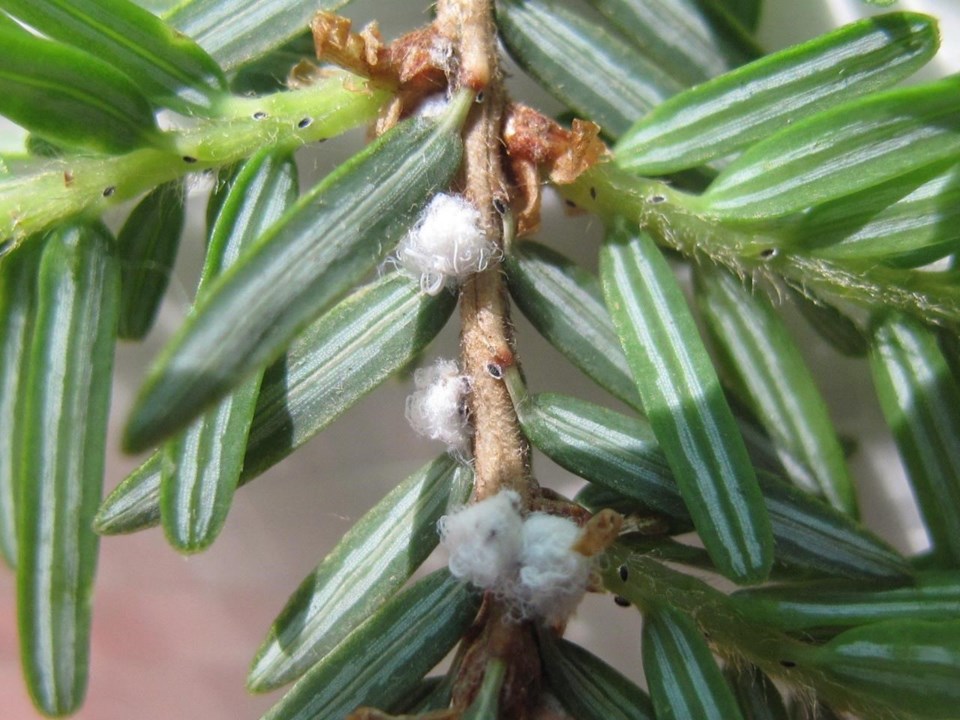FREDERICTON — On comfortable beds of wood shavings inside multiple boxes, 3,600 Laricobius nigrinus beetles made overnight journeys last month from the forests of British Columbia all the way to southwestern Nova Scotia.
The Lari, as the beetles are affectionately nicknamed by some scientists who study them, were imported to help protect hemlocks from the woolly adelgid, an invasive species that came from Japan.
"The idea is that this first year is a kind of a pilot project to see if this insect will survive Nova Scotia's winters," said Lucas Roscoe, research scientist with the Canadian Forest Service.
"As the project develops, we'll be monitoring the beetle on the landscape and looking for it and seeing if it's tracking these hemlock woolly adelgid populations across the landscape."
The woolly adelgid, about the size of a peppercorn, was first seen in southwestern Nova Scotia in 2017 and has since spread northward, he said.
After landing on a tree, it settles in one spot for most of its life and begins "literally sucking the life out" of the tree after piercing the bark, Roscoe said. It gets its name from the white, woolly layer it develops. "And it's within this kind of woolly ball that it lays its eggs, and then the eggs hatch, and then they spread," he said.
Aided by milder winters on the East Coast, the woolly adelgid seems to have adapted to the area, and spread to large swaths of hemlocks. If left to spread unchecked, Roscoe said the insect would wipe out 90 per cent of hemlocks in Nova Scotia. The pest has also been seen in parts of Ontario.
"Entire stands can be damaged quite severely by the hemlock woolly adelgid," he said. "There's areas where there's a lot of hemlock trees and you're seeing most of the stand damaged or dead."
The woolly adelgid is transferred from one tree to another by wind, birds, animals or even humans, he added. "They can land on your shirt, you won't even know. You'll go for a walk and move it."
Enter the beetle.
"It's like a ladybug, but it's very small … one to two millimetres in length," Roscoe said, describing the predator. "It's just a little black beetle, but they just love eating hemlock woolly adelgid."
He took part in the release of some beetles over the past month in Nova Scotia. "I watched the beetles leave the cup and immediately start eating hemlock woolly adelgid," he said. "They crawled right up, and they just stuck their head right into one and just started eating it."
Gwylim Blackburn, a research scientist at the Pacific Forestry Centre in Victoria, said foresters in British Columbia tapped on hemlock branches to knock off the beetles and collect them in nets for shipment to Nova Scotia. "They're actually quite easy to miss, until you have a trained eye," he said.
While it is the first time this kind of biocontrol has been used on Canadian hemlocks, he said the beetles have been used to control woolly adelgid in the United States for about 20 years.
Research on the woolly adelgid was pioneered by a Canadian scientist in the 1980s and the beetles' effectiveness has since been shown to have concrete results, Blackburn said. Current research, including introduction of the beetles in Nova Scotia, has brought together different branches of governments and Indigenous communities and is drawing lessons from the United States, he added.
Chemical treatments have also been used to kill the woolly adelgid but they have proven expensive. "They're very work-intensive and of course can only be conducted on individual trees with great worker investment," Blackburn said. "What we need here for a pest spreading across a landscape is a landscape-scale solution."
Roscoe said the Nova Scotia project will cost about $72,000, which includes shipping the beetles from B.C. "It's definitely quite a good investment if we're going to save hemlock," he said.
Blackburn said that when the beetle was first introduced in eastern United States about 20 years ago, scientists were concerned it might become an invasive species itself. But long-term monitoring has shown the beetle doesn't have what scientists refer to as "off-target effects" and it only attacks the woolly adelgids on hemlocks, he noted.
Hemlocks are a keystone species, meaning large populations depend on these trees, Roscoe said.
"They can grow in areas that not very many other trees can grow in and thrive in places like river valleys, or streams, alongside lakes and ponds," he said.
"There's a lot of other species like insects, other plants and birds, small mammals that need hemlock in order to survive themselves. Removing hemlock from these areas where it's the majority constituent would lead to a complete ecological collapse in these areas. So, basically, kind of a biodiversity desert."
The main task for scientists now is to monitor how the beetle fares over the frigid and sustained Nova Scotia winter.
"It's tough to say right now," Roscoe said. "We're going to check on them — probably February, March — and we're going to see."
This report by The Canadian Press was first published Nov. 19, 2023.
Hina Alam, The Canadian Press



